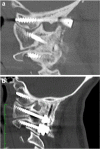Safety analysis and complications of condylar screws in a single-surgeon series of 250 occipitocervical fusions
- PMID: 34820740
- PMCID: PMC8913474
- DOI: 10.1007/s00701-021-05039-z
Safety analysis and complications of condylar screws in a single-surgeon series of 250 occipitocervical fusions
Abstract
Objective: Condylar screw fixation is a rescue technique and an alternative to the conventional configuration of occipitocervical fusion. Condylar screws are utilized when previous surgical bone removal along the supraocciput has occurred which makes anchoring of a traditional barplate technically difficult or impossible. However, the challenging dissection of C0-1 necessary for condylar screw fixation and the concerns about possible complications have, thus far, prevented the acquisition of large surgical series utilizing occipital condylar screws. In the largest case series to date, this paper aims to evaluate the safety profile and complications of condylar screw fixation for occipitocervical fusion.
Methods: A retrospective safety and complication-based analysis of occipitocervical fusion via condylar screws fixation was performed.
Results: A total of 250 patients underwent occipitocervical fusions using 500 condylar screws between September 2012 and September 2018. No condylar screw pullouts, or vertebral artery impingements were observed in this series. The sacrifice of condylar veins during the dissection at C0-1 did not cause any venous stroke. Hypotrophic condyles were found in 36.4% (91 of the 250) cases and did not prevent the insertion of condylar screws. Two transient hypoglossal deficits occurred at the beginning of this surgical series and were followed by recovery a few months later. Corrective strategies were effective in preventing further hypoglossal injuries.
Conclusions: This surgical series suggests that the use of condylar screws fixation is a relatively safe and reliable option for OC fusion in both adult and pediatric patients. Methodical dissection of anatomical landmarks, intraoperative imaging, and neurophysiologic monitoring allowed the safe execution of the largest series of condylar screws reported to date. Separate contributions will follow in the future to provide details about the long-term clinical outcome of this series.
Keywords: Cranial vertebral fixation; Occipital condyle; Occipital condyle screw; Occipitocervical fusion.
© 2021. The Author(s).
Conflict of interest statement
The authors declare no competing interests.
Figures







References
-
- Bekelis K, Duhaime AC, Missios S, Belden C, Simmons N. Placement of occipital condyle screws for occipitocervical fixation in a pediatric patient with occipitocervical instability after decompression for Chiari malformation: Case report. J Neurosurg Pediatr. 2010;6(2):171–176. doi: 10.3171/2010.4.PEDS09551. - DOI - PubMed
MeSH terms
LinkOut - more resources
Full Text Sources

